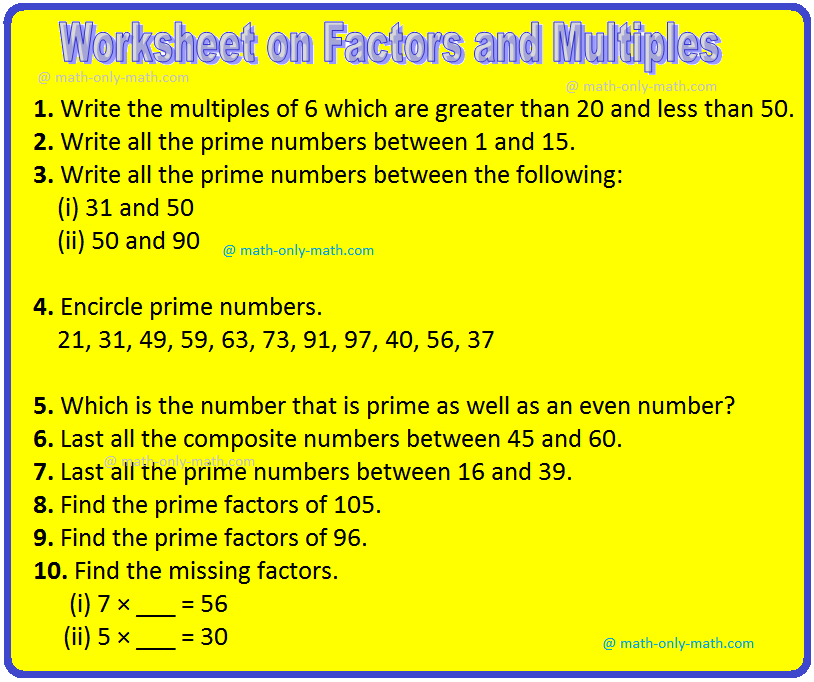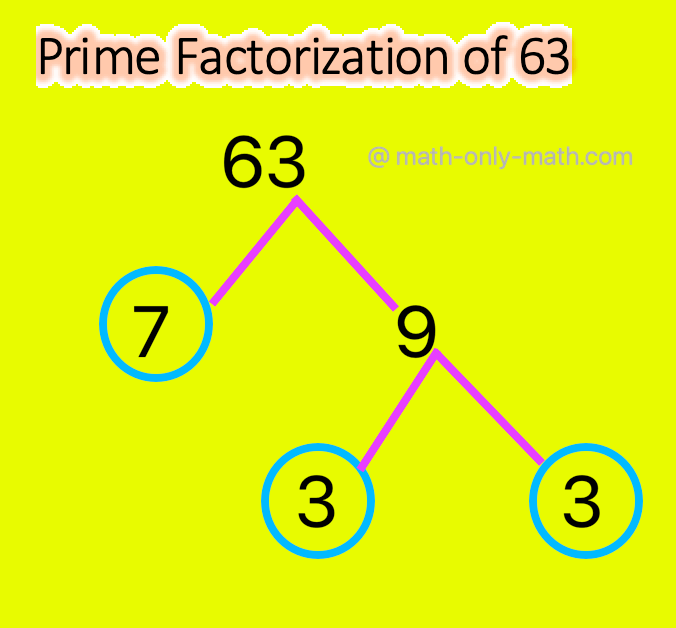Subscribe to our ▶️ YouTube channel 🔴 for the latest videos, updates, and tips.
Worksheet on Factors and Multiples
Practice the questions given in the worksheet on factors and multiples.
1. Find out the even numbers.
27, 36, 48, 125, 360, 453, 518, 423, 54, 58, 917, 186, 423, 928, 358
2. Find out the odd numbers.
10, 45, 78, 146, 347, 543, 495, 638, 497, 968, 729, 427, 624, 572
3. Write the factors of the following:
(i) 27
(ii) 32
(iii) 18
(iv) 45
(v) 25
(vi) 56
(vii) 68
(viii) 38
(ix) 72
(x) 56
(xi) 49
(xii) 30
(xiii) 95
(xiv) 36
(xv) 84
4. Write the first five multiples of the following:
(i) 4
(ii) 3
(iii) 7
(iv) 9
(v) 5
(vi) 8
(vii) 12
(viii) 15
5. Find the first three multiples of 8.
6. Find the missing factors.
(i) 7 × ___ = 56
(ii) 5 × ___ = 30
(iii) ___ × 3 = 24
(iv) ___ × 9 = 72
(v) 6 × ___ = 48
(vi) 8 × ___ = 72
7. Write the multiples of 6 which are greater than 20 and less than 50.
8. Write all the prime numbers between 1 and 15.
9. Write all the composite numbers between 1 and 30.
10. Write all the prime numbers between the following:
(i) 31 and 50
(ii) 50 and 90
(iii) 61 and 80
(iv) 91 and 100
11. Write all the composite numbers between the following:
(i) 40 and 50
(ii) 75 and 90
(iii) 25 and 35
(iv) 50 and 70
12. Encircle prime numbers.
21, 31, 49, 59, 63, 73, 91, 97, 40, 56, 37
13. Tick (✔) the true statement and cross (✘) the false one:
(i) 6 is a factor of 72.
(ii) 18 is a factor of 55.
(iii) 10 is a factor of 100.
(iv) 3 is a factor of 63.
(v) 5 is a factor of 35.
(vi) 1 is a factor of every number.
(vii) 48 is the largest factor of 48.
(viii) 2 is a factor of 32.
14. Fill in the blanks:
(i) 9 × 11 = 99 implies that 99 is a _____ of 9 and 11.
Also 9 and 11 are _____ of 99.
(ii) 7 × 8 = 56 implies that 56 is a _____ of 7 and 8.
Also 7 and 8 are _____ of 56.
(iii) 12 × 13 = 156 implies that 13 and 12 are _____ of 156 and 156 is a _____ of 12.
15. Which of the following statements are correct?
(i) 1 is a composite number.
(ii) All the odd numbers are the prime numbers.
(iii) A composite numbers has at least 3 factors.
(iv) A number is the greatest factor of itself.
(v) 1 is a factor of every number.
(vi) The multiples of a number are limited.
(vii) A prime number is always even
(viii) A number is either composite or prime.
(ix) A prime number has only two factors.
(x) Every multiple of a number is exactly divisible by the number.
16. Wine the smallest and the largest factor of 180.
17. Which of the following numbers are divisible by 9
23,1176; 41,102; 52,056; 1,70,766
18. The factor of a non-zero number is either greater than or equal to the number. Is it true?
19. Which is the number that is prime as well as an even number?
20. Last all the composite numbers between 45 and 60.
21. Last all the prime numbers between 16 and 39.
22. Find the prime factors of 105.
23. Find the prime factors of 96.
24. Draw a factor tree to find the prime factorization of 63.
25. Find the H.C.F. of:
(i) 20 and 25
(ii) 4 and 6
(iii) 10 and 15
(iv) 15 and 20
(v) 16 and 60
(vi) 14 and 35
26. Find the LC.M. of the following numbers:
(i) 6 and 10
(ii) 3 and 6
(iii) 10 and 12
(iv) 4 and 9
(v) 15 and 18
(vi) 6 and 11
(vii) 9 and 18
(viii) 7 and 14
(ix) 8 and 12
(x) 8 and 16
27. Find all the common factors of
(i) 8 and 12
(ii) 10 and 28
(iii) 12 and 24
(vi) 21 and 49
(v) 20 and 50
(vi) 17 and 51
(vii) 20 and 25
(viii) 24 and 48
(ix) 16 and 24
28. Find:
(i) the first two common multiples of 3 and 5.
(ii) the first three common multiples of 5 and 3
(iii) the first two common multiples of 5 and 10
29. Multiple Choice Questions (MCQ) on Factors and Multiples:
Tick (✔) the correct option.
(i) A number, which is a factor of every number, is
(a) 0; (b) 2; (c) 1; (d) 3
(ii) The first multiple of 7 is
(a) 1; (b) 7; (c) 14; (d) Both (a) and (c)
(iii) The common factor (except 1) of 121, 143 and 176 is
(a) 7; (b) 17; (c) 13; (d) 11
30. Find the all factors of the following numbers:
(i) 8
(ii) 18
(iii) 21
(iv) 25
(ν) 48
(vi) 15
(vii) 42
(viii) 54
31. Find the first three multiples of the following numbers:
(i) 5
(ii) 12
(iii) 6
(iv) 11
(v) 4
(vi) 16
32. Write down the first five multiples of the given numbers:
(i) 4
(ii) 10
(iii) 9
(iv) 25
(v) 18
(vi) 12
33. Find the ninth multiple of 90.
34. Find the multiples of 9 between 35 and 84.
Answers for the worksheet on factors and multiples are given below.
Answers:
1. 36, 48, 360, 518, 54, 58, 186, 928, 358
2. 45, 347, 543, 495, 497, 729, 427
3. (i) 1, 3, 9, 27
(ii) 1, 2, 4, 8, 16, 32
(iii) 1, 2, 3, 6, 9, 18
(iv) 1, 3, 5, 9, 15, 45
(v) 1, 5, 25
(vi) 1, 2, 4, 7, 8, 14, 28, 56
(vii) 1, 2, 4, 17, 34, 68
(viii) 1, 2, 19, 38
(ix) 1, 2, 3, 4, 6, 8, 9, 12, 18, 24, 36, 72
(x) 1, 2, 4, 7, 8, 14, 28, 56
(xi) 1, 7, 49
(xii) 1, 2, 3, 5, 6, 10, 15, 30
(xiii) 1, 5, 19, 95
(xiv) 1, 2, 3, 4, 6, 9, 12, 18, 36
(xv) 1, 2, 3, 4, 6, 7, 12, 14, 21, 28, 42, 84
4. (i) 4, 8, 12, 16, 20
(ii) 3, 6, 9, 12, 15
(iii) 7, 14, 21, 28, 35
(iv) 9, 18, 27, 36, 45
(v) 5, 10, 15, 20, 25
(vi) 8, 16, 24, 32, 40
(vii) 12, 24, 36, 48, 60
(viii) 15, 30, 45, 60, 75
5. 8, 16, 24
6. (i) 8
(ii) 6
(iii) 8
(iv) 8
(v) 8
(vi) 9
7. 24, 30, 36, 42, 48
8. 2, 3, 5, 7, 11, 13
9. 4, 6, 8, 9, 10, 12, 14, 15, 16, 18, 20, 21, 22, 24, 25, 26, 27, 28, 30
10. (i) 31, 37, 41, 43, 47
(ii) 53, 59
(iii) 61, 67, 71, 73, 79
(iv) 97
11. (i) 42, 44, 45, 46, 48, 49, 50
(ii) 75, 76, 77, 78, 80, 81, 82, 84, 85, 86, 87, 88, 90
(iii) 25, 26, 27, 28, 30, 32, 33, 34, 35
(iv) 40, 51, 52, 54, 55, 56, 57, 58, 60, 62, 63, 64, 65, 66, 68, 69, 70
12. 31, 59, 73, 97, 37
13. (i) ✔
(ii) ✘
(iii) ✔
(iv) ✔
(v) ✔
(vi) ✔
(vii) ✔
(viii) ✔
14. (i) multiple, factors
(ii) multiple, factors
(iii) factors, multiple
15. (iii), (iv), (v), (ix), (x)
16. Smallest Factor = 1, Largest Factor = 180.
17. 52,056; 1,70,766
18. False
19. 2
20. 46, 48, 49, 50, 51, 52, 54, 55, 56, 57, 58
21. 17, 19, 23, 29, 31, 37
22. 3, 5 7
23. 2, 3
24.
25. (i) 5
(ii) 2
(iii) 5
(iv) 5
(v) 4
(vi) 7
26. (i) 30
(ii) 6
(iii) 60
(iv) 36
(v) 90
(vi) 66
(vii) 18
(viii) 14
(ix) 24
(x) 16
27. (i) 1, 2, 4
(ii) 1, 2
(iii) 1, 2 ,3, 4, 6
(vi) 1, 7
(v) 1, 2, 5, 10
(vi) 1, 17
(vii) 1, 5
(viii) 1, 2, 3, 4, 6, 8, 12, 24
(ix) 1, 2, 4, 8
28. (i) 15, 30
(ii)15, 30, 45
(iii)10, 20
29. (i) (c) 1
(ii) (b) 7
(iii) (d) 11
30. (i) 8 = 1, 2, 4, 8
(ii) 18 = 1, 2, 3, 6, 9, 18
(iii) 21 = 1, 3, 7, 21
(iv) 25 = 1,5, 25
(ν) 48 = 1, 2, 3, 4, 6, 8, 12, 16, 24, 48
(vi) 15 = 1, 3, 5, 15
(vii) 42 = 1, 2, 3, 6, 7, 14, 21, 42
(viii) 54 = 1, 2, 3, 6, 9, 18, 27, 54
31. (i) Three multiples of 5 are 5, 10, 15
(ii) Three multiples of 12 are 12, 24, 36
(iii) Three multiples of 6 are 6, 12, 18
(iv) Three multiples of 11 are 11, 22, 33
(v) Three multiples of 4 are 4, 8, 12
(vi) Three multiples of 16 are 16, 32, 48
32. (i) First five multiples of 4 are 4, 8, 12, 16, 20
(ii) First five multiples of 10 are 10, 20, 30, 40, 50
(iii) First five multiples of 9 are 9, 18, 27, 36, 45
(iv) First five multiples of 25 are 25, 50, 75, 100, 125
(v) First five multiples of 18 are 18, 36, 54, 72, 90
(vi) First five multiples of 12 are 12, 24, 36, 48, 60
33. The ninth multiple of 90 is 810.
34. The multiples of 9 between 35 and 84 are 36, 45, 54, 63, 72, 81.
From Worksheet on Factors and Multiples to HOME PAGE
Didn't find what you were looking for? Or want to know more information about Math Only Math. Use this Google Search to find what you need.




New! Comments
Have your say about what you just read! Leave me a comment in the box below. Ask a Question or Answer a Question.